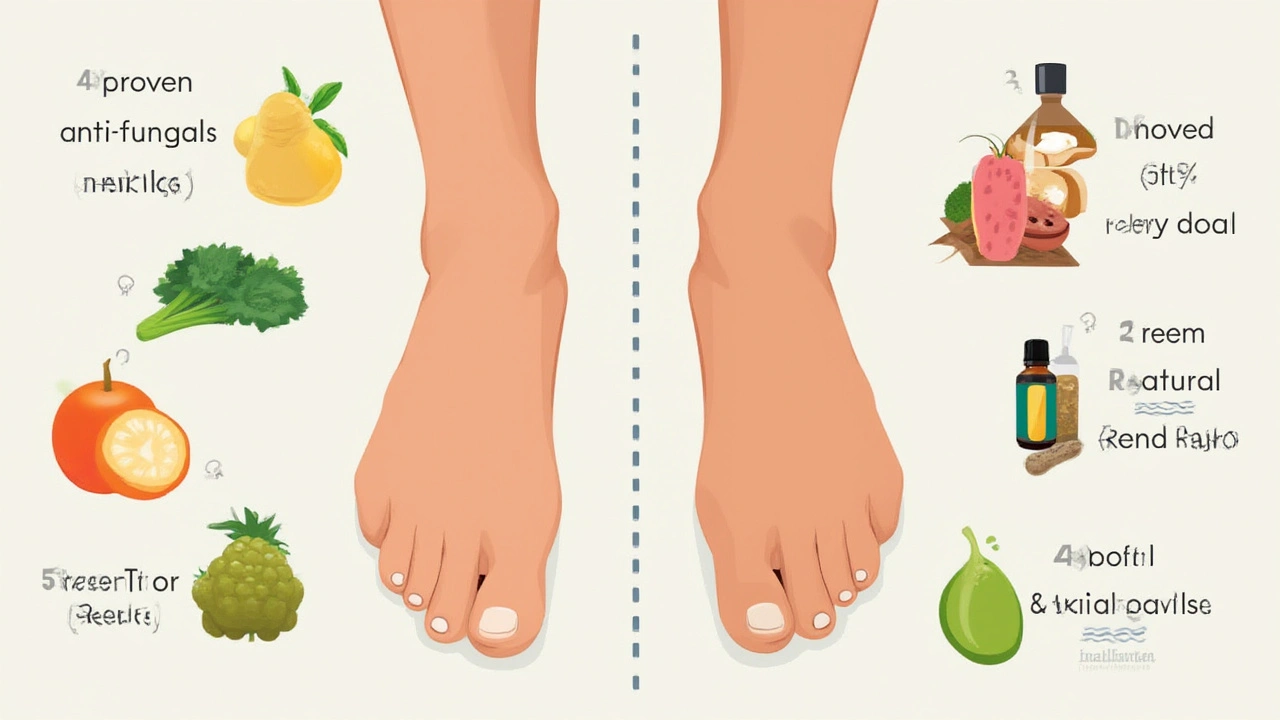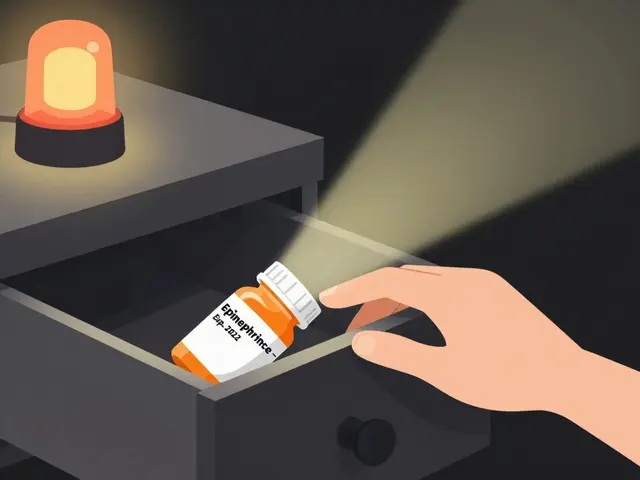That itch between your toes isn’t just annoying; it’s practically begging for a solution. Most people grab an antifungal cream (butenafine is a popular choice in the UK), steamroll the infection, and move on. But what if you want to go the natural route? There’s this whole movement now—toss the chemicals, trust the earth. But does nature actually come through, or is it all hype?
What Actually Is Butenafine and Why Are People Looking for Alternatives?
Butenafine is a synthetic antifungal cream mostly prescribed for athlete’s foot, ringworm, and jock itch. It works by stopping the fungus from reproducing, wiping out that itchy, flaky mess remarkably fast for most folks. Downside? It’s not magic. Side effects like redness, irritation, or even blisters can show up, especially for those of us with sensitive skin. That’s exactly what nudges people toward natural options. Personally, I remember Milena once said she couldn’t bear the chemical smell from some creams—that was enough reason for her to raid our kitchen cupboard for alternatives.
Now, fungal infections are nothing to mess around with. According to NHS data, about 10% of people in the UK deal with athlete’s foot at any given time. Most cases aren’t dangerous, but they can make life uncomfortable. Going natural might seem friendlier to your body, but it all comes down to one thing: do natural antifungal remedies actually work?
Let’s face it—our grandparents didn’t have butenafine. They had pantry stapes and folk wisdom. Some of their go-tos sound odd, but there’s real science buried in the tradition. Here’s what the studies show about the most popular natural remedies.

What Science Says About Common Natural Remedies
Not all natural alternatives are cut from the same cloth. Some, like tea tree oil, come with hard evidence. Others? Let’s just say putting garlic in your socks won’t win you many friends or much relief. Here’s the breakdown of what works, what kind of works, and what probably isn’t worth your time.
- Tea tree oil: The hero of natural antifungals. A study published in the Australasian Journal of Dermatology (2002) found that 50% tea tree oil solution cleared athlete’s foot in 64% of patients, compared to just 31% for a placebo. Not too shabby. But there’s a snag: high concentrations can cause skin irritation, so always dilute it—2-3 drops in a tablespoon of carrier oil does the trick for most.
- Coconut oil: There’s more to this kitchen staple than pancakes. Lauric acid and caprylic acid, found in coconut oil, seem to bust up the fungus cell walls. While coconut oil may not be powerful enough for a raging infection, it can soothe mild cases and help with dry, cracked skin that fungus loves to burrow into.
- Apple cider vinegar: Old school, acidic, and surprisingly effective against certain fungi. Lab tests (like one in the Journal of Prosthodontics, 2015) showed ACV can zap Candida strains. For athlete’s foot, a foot soak with one part vinegar to two parts water helps shift pH away from what fungus likes. Just watch for stinging if the skin’s cracked.
- Garlic: Packed with allicin, a proven antifungal in lab studies. But here’s the rub: raw garlic paste burns. Like, really burns. If you must, try a patch test first—mix a tiny amount with olive oil, dab it on, and wait for any reaction.
There’s a whole world of natural oils—oregano, neem, eucalyptus—but the data gets iffy fast. Yes, they kill fungus in petri dishes, but your skin’s a trickier battlefield. Also, never use these essential oils undiluted; you’ll end up with chemical burns instead of soothing relief.
| Remedy | Main Compound | Evidence | Notes |
|---|---|---|---|
| Tea Tree Oil | Terpinen-4-ol | Strong clinical data | Must dilute, can irritate |
| Coconut Oil | Lauric acid | Limited human data | Safe for skin, mild |
| Apple Cider Vinegar | Acetic acid | Lab only | May sting open skin |
| Garlic | Allicin | Lab only | Can severely irritate |
If you wonder about turmeric—yes, it’s anti-inflammatory, but not a proven topical antifungal. It can dye your feet yellow though, which isn’t usually the goal.
Here’s where things get interesting. A lot of products you see online, slapping "natural" everywhere, just don’t have research or real-world evidence behind them. Herbal powders, foot soaks, and bizarre-sounding supplements (like colloidal silver) haven’t outperformed placebos in good studies. Always check for trustworthy sources—not anonymous reviews on shopping sites.
Still skeptical? Dr. Adam Friedmann, consultant dermatologist at The Harley Street Clinic, puts it like this:
“Natural remedies can provide relief for mild infections, but for stubborn or worsening symptoms, you’re usually better off sticking with medically approved antifungals.”

Smart Tips If You Want to Go Natural
Is it worth ditching the butenafine and braving the natural route? You’ll need to be patient and smart about it. The biggest mistake people make is expecting overnight results. Fungi have tough cell walls and clever ways to hide from both drugs and oils. If you choose natural antifungals, you’ll likely be at it for weeks, not days.
- Patch test everything. Essential oils and vinegar can burn just as easily as chemical creams. Try a small spot first for 24 hours before slathering your feet.
- Keep feet clean and dry. Fungi thrive in moisture. Swap socks daily, use a hair dryer on cool to zap between your toes, and give your shoes a day off to air out.
- Trim toenails regularly. Fungi love to camp under long or thick nails.
- Avoid walking barefoot in shared areas. Swimming pools, gyms, and even hotel carpets are fungal hotspots.
- If the infection spreads or gets worse, see a doctor. Some things look like fungus but aren’t—eczema, psoriasis, or even bacterial infections need proper care.
I’ve found that these commonsense steps, combined with a proven natural remedy (like tea tree oil—but always diluted), work for minor cases. My mate Dave tried apple cider vinegar soaks after a rugby trip left his feet in shambles. It stung at first, but his foot improved over two weeks. Not a miracle fix, but it got the job done. Milena, on the other hand, will only trust coconut oil. She likes how gentle it feels, even if it’s slower than the pharmacy creams.
There’s still room for new research. Scientists in Manchester are even studying how different essential oils block fungal enzymes. The future of natural antifungals is promising, especially if you want fewer chemicals in your life. But know this: if the infection lingers or your nails start to crumble, it's time to use the pharmacy’s heavy-hitters. That’s nothing to feel guilty about.
Natural alternatives to butenafine aren’t just a trendy option—they might fit if you’re looking for mild, skin-friendly, and do-it-yourself solutions, especially for early or light fungal infections. Use them wisely. And whatever else you do, resist the urge to go barefoot at the gym showers—no oil or cream beats good hygiene for keeping fungus at bay.




Nathan Brown
July 23, 2025 AT 21:54It’s funny how we’ve forgotten that our grandparents didn’t need prescriptions to beat a fungal infection. They had garlic, vinegar, and common sense. Now we’re out here buying $40 bottles of ‘organic’ tea tree oil like it’s liquid gold. Nature’s been doing this for millennia-maybe we just need to stop overcomplicating it.
Olivia Currie
July 25, 2025 AT 20:29TEA TREE OIL IS A GAME CHANGER!!! I used it during my backpacking trip in Nepal-no pharmacy in sight, just a tiny bottle and some coconut oil. Two weeks later? My feet looked like they’d never met a fungus. Also, it smells like a forest after rain. 🌿✨
farhiya jama
July 26, 2025 AT 11:51Ugh. Another ‘natural remedy’ post. Can we just admit that most of this stuff is placebo with extra steps? I tried vinegar soaks for a month. My feet looked worse. I bought butenafine on Amazon. Done in 3 days. Why do people romanticize suffering?
Daniel Rod
July 27, 2025 AT 19:46My grandma used to rub raw garlic on her feet and say ‘the devil hates garlic.’ She lived to 94. I don’t know if it was the garlic or just the fact she never wore socks indoors. But I do know this: if you’re gonna try natural, start with coconut oil. It’s like giving your feet a hug. 🤗
Curtis Ryan
July 28, 2025 AT 10:06yo i tried apple cider vinegar and it burned so bad i cried and then my roommate laughed and said ‘bro you just made your feet a sour patch kid’ lol. but honestly after 2 weeks my toe fungus started fading. not magic, but better than nothing. also don’t use undiluted vinegar. i learned the hard way. 🤕
Ifeoma Ezeokoli
July 28, 2025 AT 20:37Back in Lagos, we used neem leaves boiled in water and soaked our feet. My auntie swore by it. No fancy bottles, no labels-just the tree outside her house. I tried it last year when I got athlete’s foot after a trip home. Took longer than cream, but no irritation. And honestly? It felt more… connected. Like I was healing with my roots, not just masking it.
Sue Barnes
July 29, 2025 AT 21:23Tea tree oil is not a cure. It’s a distraction. People think natural = safe, but that’s the dumbest myth going. You’re putting concentrated plant chemicals on broken skin. That’s not holistic. That’s reckless. If you have a fungal infection, see a doctor. Stop playing alchemist in your bathroom.
Melissa Michaels
July 31, 2025 AT 08:02As someone who’s dealt with chronic fungal infections for over a decade, I can say this: natural remedies can help with maintenance, but they’re not replacements for medical treatment in moderate to severe cases. I use tea tree oil mixed with aloe vera as a preventive after showers, but when it flares up? Prescription cream. No shame in that. Your body deserves evidence-based care, not TikTok trends.
DENIS GOLD
August 2, 2025 AT 06:11Of course natural works. The government doesn’t want you to know. Butenafine is a Big Pharma scam. They’re scared of tea tree oil because it costs $12 and kills fungus better than their $60 cream. Wake up sheeple. 🇺🇸
Matthew Stanford
August 4, 2025 AT 01:54Just want to say-dry feet are the real MVP. No matter what remedy you use, if your toes stay damp, you’re fighting a losing battle. I started using a small fan under my desk at work. Weird? Maybe. Effective? Absolutely. My feet haven’t been itchy in 14 months.
gina rodriguez
August 4, 2025 AT 09:09My sister used coconut oil religiously and it worked for her mild case. I tried it too and it felt so nice-like a little self-care ritual. I didn’t expect it to fix anything, but it made me feel like I was doing something kind for my body. Sometimes that matters as much as the science.
Rajiv Vyas
August 4, 2025 AT 21:37Tea tree oil is a controlled substance in 3 countries. They don’t want you to know it works. Also, the NHS says 10% get athlete’s foot? That’s a lie. They’re hiding the real numbers because they’re paid by Big Antifungal. I’ve seen videos of people curing it with lemon juice and salt. They deleted the videos. They’re scared.
jobin joshua
August 6, 2025 AT 18:49bro i used garlic paste on my toes and my skin turned red and then i cried and then i used aloe vera and then my friend said ‘you look like a tomato’ 😂 but it worked? kinda? my nails are better. but now i smell like a pizza. worth it? maybe. 🤷♂️
Astro Service
August 7, 2025 AT 15:22Why are we even talking about this? America has the best medicine in the world. If you can’t fix a fungus with a real drug, you’re doing it wrong. Tea tree oil? That’s for hippies. Get a prescription and stop wasting time.